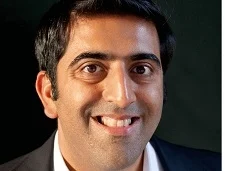Fixed Income Robot Wars & the Rise of the Machines
17th November, 2014|External Author

Electronic trading methods are set to dominate the fixed income market
By Hirander Misra, CEO of GMEX Group
Continuing global regulatory reform, is leading to significantchange in financial markets across all asset classes. Change causes disruptionand disruption presents opportunity with winners and losers.
Winners will be new entrants or existing players who adapt –succeeding at the detriment of those who remain attached to the old ways ofdoing things. No one knows who they will be but one thing is apparent, with anaccelerated timeline, the financial markets landscape will change dramaticallyin the years to come.
Electronic transformation of cash equities markets was drivenby waves of regulation from the mid 1990s to late 2000s. The effect on otherasset classes is likely to be magnified given the wider scope of the new regulations.Will we see the trend that manifested itself in the equity markets play out infixed income markets with the advent of more automated and algorithmic trading?
Regulatory changes, enabled by advances in technology, have ledto the rise of electronic trading of fixed-income securities. Although, tothis day, approximately 50% of U.S. government-bond trades and 80% of creditmarkets and corporate bonds are still negotiated and traded telephonically (dueto structural issues primarily centred around the lack of size and liquidity).Plain vanilla interest rate swaps and government bonds are easier to automateas they are more standardised, while mortgage bonds and corporate bonds areless standardised and therefore harder to automate.
Transparency driven by regulation and technology innovationcan act as the catalyst to drive more electronic price discovery and, ascritical mass builds with a good mix of buy-side and sell-side liquidity in anygiven trading venue, so will order driven trading. However, the negotiationmodel works well for less liquid instruments and will not die any time soonalbeit it will be screen based with smarter use of automated price discovery ratherthan phone traded. New business models will emerge and we are already seeing aplethora of players trying to compete, with the aim of changing the existingmodel, such as Deutsche Börse backed Bondcube, Liquidnet’s acquisition of Vega-Chiand ITG, the latter two capitalising on what has succeeded in cash equitiesmarkets. However, lessons should be learnt and those who believe simply applyingequities-like models to them will succeed will be proven wrong.
Transparent trading on SEFs will also help the broader causeof these markets, be it in credit or interest rate swaps (IRS). In Europe weare seeing traditional buy-side firms, looking to in-source their trading desksand take more control of their execution strategy, replacing prime broker phonetrading with in-house systems beyond the standard Execution Management Systemsto full-suite Order Management Systems. Vendors are also looking to capitaliseon fixed income automation with those, such as Trading Technologies, expandingtheir already mature fixed income futures offerings into the more traditionalfixed income space with a suite of automated trading and analytics tools tohelp optimise execution. There are new players entering these markets bringingadditional liquidity, such as Citadel, as a swaps dealer. Other non-traditionalplayers are likely to follow to add liquidity to the market place as some ofthe sell-side’s appetite for market-making wanes, given balance sheetconstraints and reduced risk appetite. Allthis will further drive the automation momentum. It will also presentopportunities for automated hedging tools between fixed income and fixed incomederivatives markets. At GMEX for example, we see opportunity to utilise automatedstrategies to hedge a 30 year gilt issue with our IRS constant maturity futuresproducts and continually adjusting the hedge not only for this but for amultitude of other instruments given the already mature liquid nature of fixedincome derivatives offerings on exchanges both at the short and the long end ofthe curve.
Stephane Malrait who is Head of eCommerce FX & FI ofSociete Generale recently cited that automation and auto hedging will becomethe norm in IRS markets and JP Morgan has introduced an automated trading suite,Quantitative Market Maker, to automate fixed income pricing and trading. Thistrend to automate sell-side fixed income desks will only accelerate and is startingto play out at some of the larger banks with some human capital movement fromthe cash equities side and set up of e-trading teams and associated strategies.One such example is the UBS NEO platform, which aggregates liquidity from thevarious SEF venues as well as fixed income exchange traded derivatives marketsto offer their buy-side client base integrated smart tools for execution.
Interdealer brokers have seen their voice broking revenuesfall coupled with high costs and over reliance on the sell-side. They areaddressing this by further electronic platform provision beyond their SEF solution.John Phizackerley, the newly appointed CEO of Tullett Prebon recently citedthat the key focus would be in this area. Others, like Tradition have focusedheavily on their electronic trading strategy through the Trad-X platformoffering run by Daniel Marcus with ICAP also having various offerings includingiSwap and Brokertec.
Whilst fixed income desks have been extremely profitableover the last few years, there is a growing realisation that change will leadto revenue erosion and those who keep their heads buried in the sand will suffocate.It is a case of adapting or dying a slow death with a thousand cuts. There willbe resistance from those within the organisation that have the most to lose,but this must be overcome more centrally to ensure that best interests prevail.The robots have not taken over yet but their march will continue at anincreasing pace. Nonetheless, much like other automated markets, effective on-goingregulation and human oversight will be key ingredients to preserve marketintegrity so that the age of the machines does not lead to a terminally ill stateof the market and the humans remain in control.


